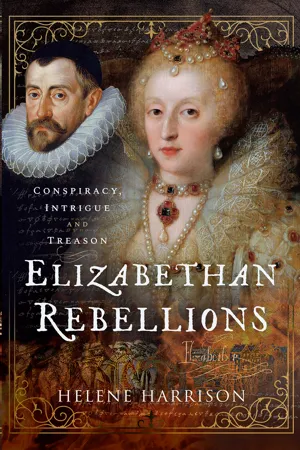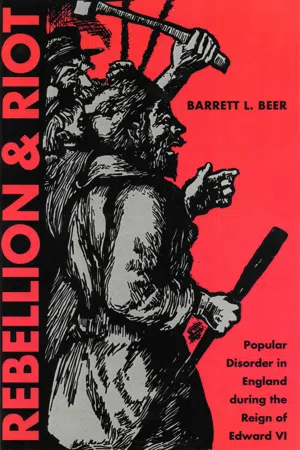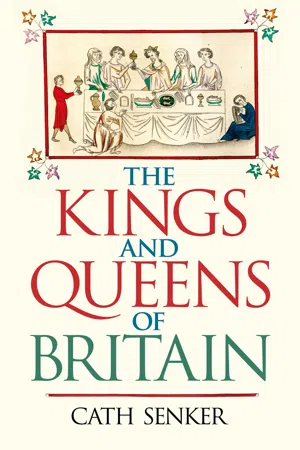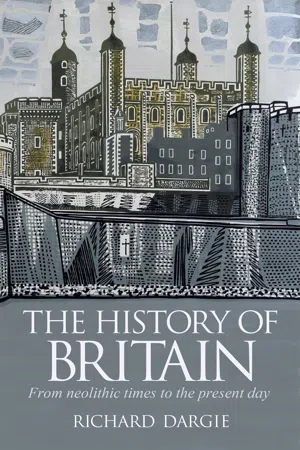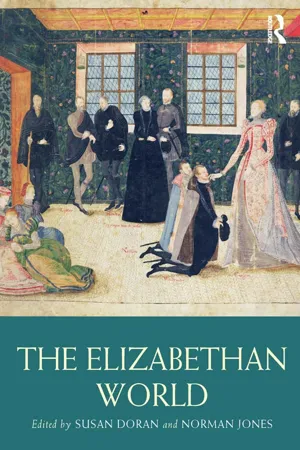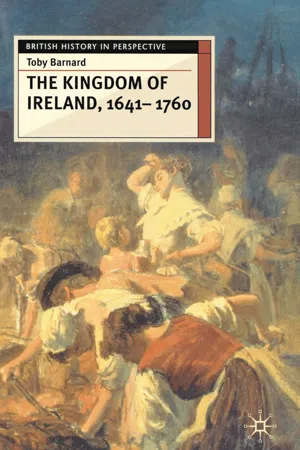History
Tudor Rebellions
The Tudor Rebellions were a series of uprisings in England during the 16th century, occurring under the rule of the Tudor monarchs. These rebellions were often driven by religious, social, or economic grievances, and they posed significant challenges to the authority of the ruling monarchs. The most notable rebellions include the Pilgrimage of Grace, Wyatt's Rebellion, and the Prayer Book Rebellion.
Written by Perlego with AI-assistance
Related key terms
7 Key excerpts on "Tudor Rebellions"
- eBook - ePub
Elizabethan Rebellions
Conspiracy, Intrigue and Treason
- Helene Harrison(Author)
- 2023(Publication Date)
- Pen and Sword History(Publisher)
Chapter 1Early Tudor Rebellions
‘Rebels, enemies, and traitors’1The Tudor dynasty suffered a number of rebellions and each monarch of the dynasty had at least one major revolt to deal with during their time on the throne. As Henry VII had seized the throne on the battlefield at Bosworth in 1485, perhaps this was understandable. Not all of the citizens, especially the nobility, accepted the Tudors as rightful kings and queens. there were surviving Plantagenet heirs who were preferable to many. The monarchs’ responses to these rebellions can also be understood in the context of the Wars of the Roses which were still in living memory, even to a few when Elizabeth I came to the throne in 1558, though more so in the reigns of Henry VII and Henry VIII. Perhaps because the Tudors seemed to have a problem in providing male heirs the dynasty was seen as unstable which may have prompted at least some of the rebellions against them.The rebellions under the Tudor monarchs seem to mainly fall into two categories: succession and religion. These were the main issues that the Tudor monarchs were preoccupied with, particularly Henry VIII, whose reign was hugely affected by both issues, though Elizabeth I was also affected by both as will be seen. Henry VIII divorced his first wife, Katherine of Aragon, and beheaded his second, Anne Boleyn, in order to get a son by his third wife, Jane Seymour. Because Henry VII had seized the throne on the battlefield, he had drilled into his son how vulnerable the Tudor dynasty was and Henry VIII had taken that to heart. Henry VIII also knew from first-hand experience that one son was not enough to secure the succession; his elder brother, Arthur, had died in 1502, leaving him unexpectedly as heir to the throne. This explains Henry’s further three marriages after Jane Seymour’s death in 1537, just days after the birth of their son, the future Edward VI. Henry VIII’s children were also very aware of potential succession issues. Edward VI took steps to try and exclude his half-sisters from the throne, and Mary I was determined to have a son of her own to prevent Elizabeth from succeeding her. There were religious issues after the Break with Rome, known as the mid-Tudor crisis, as each monarch had a very different belief of what the religion should be in England. Tensions between Catholicism and Protestantism dominated much of the sixteenth century across Europe, not just in England. However, England and Scotland seem to be some of the only countries where religion was used as an excuse to overthrow the monarch. There was also concern over England becoming an offshoot of another country and losing its independence, as evidenced mostly by Mary I’s marriage to Philip II of Spain and the question over who Elizabeth should marry at the beginning of her reign. - eBook - ePub
Rebellion and Riot
Popular Disorder in England During the Reign of Edward VI
- John A. Andrew, III(Authors)
- 2000(Publication Date)
- The Kent State University Press(Publisher)
4Rebellion played a smaller role during the reign of Elizabeth, but even Gloriana felt the sting of revolt in 1569 when the earls of Northumberland and Westmorland restored the Latin mass at Durham Cathedral, called for the arrest of Sir William Cecil, the queen’s leading adviser, and demanded the restoration of Roman Catholicism. Less threatening than the mid-Tudor Rebellions, the rising of the northern earls revealed the deep-rooted discontent of the aristocracy and its tenants. The last rising of the Tudor era took place in 1601, only two years before the death of Elizabeth, when the Earl of Essex, frustrated by his loss of royal favor, led 200 supporters up Fleet Street, London, in a desperate and futile attempt to restore his political ascendancy.5 A survey of Tudor Rebellions leads to the inescapable conclusion that every rebel captain whether artisan or earl and every popular cause — religious, political, or economic — suffered defeat. What is remarkable and usually overlooked by historians is the courage of generations of Tudor rebels to resist oppression and go down to defeat in the face of overwhelming odds.Although popular disorder was endemic throughout the sixteenth century, the pattern of rebellion and riot was extremely diverse. The rebellion of Henry Tudor in 1485 began as a royalist conspiracy against the Yorkists, and the dynastic interests of the Courtenays and Mary Stuart played important roles in later risings. When political opposition to the Tudors was not dynastic, it usually included conflict between court and country. For example, the northern aristocracy in 1536 and 1569 and the western gentry in 1549 vigorously opposed policies emanating from the court. The leadership of Thomas Cromwell and William Cecil aroused regional discontent; remote counties feared centralizing reforms of all kinds; and in 1549 the western gentry saw the Edwardian Reformation as little more than the program of court politicians supported by a clique of heretical clergy. After Henry VIII’s break with Rome in the 1530s, religion emerged as a divisive issue that fired political and social instability. Only under Edward VI did Catholics and Protestants rise at the same time. Religious unrest during the reigns of Henry VIII and Elizabeth came primarily from Catholics opposed to the royal supremacy, the monastic dissolution, and innovations in the church, while Mary’s opponents were exclusively Protestant. Real or imagined social and economic grievances played a part in many rebellions, particularly the Cornish Rebellion of 1497, the Pilgrimage of Grace, and Kett’s Rebellion in Norfolk. Riots almost always stemmed from economic issues; frequently heard grievances concerned rent payments, food prices, enclosure, and property rights. - eBook - ePub
- Cath Senker(Author)
- 2021(Publication Date)
- Arcturus(Publisher)
The Tudors 1485–1603T he ferocious rivalry of the Houses of York and Lancaster was over, to be replaced by a new civil conflict over religion. Like a butterfly effect, the desire of Henry VIII for a divorce prompted far-reaching changes: the English Reformation and decades of struggle between Catholics and Protestants. The religious wrangling did not prevent economic development though. An era of European exploration began in Tudor times, bringing riches from trade and exploitation, and new ideas; the monarchy benefited greatly from this period of prosperity. The Tudors did not rule alone – they had to recognize the importance of Parliament in running the country and relied on talented public servants. Yet the most dynamic king and queen, Henry VIII and Elizabeth I, had a substantial personal impact on politics, economics and society.TUDOR MONARCHS
Henry VII (1485–1509) Henry VIII (1509–47) Edward VI (1547–53) Mary I (1553–58) Elizabeth I (1558–1603)HENRY VII (1485–1509)
Henry VII ended the War of the Roses, marrying Elizabeth of York to unite the houses of Lancaster and York and founding the Tudor dynasty. To stamp his authority on the land after three decades of civil war, he ruled harshly. Was his assertion of royal authority necessary to stabilize the country or did his tyrannical tendencies have a destabilizing effect? Historians today give a mixed verdict on the success of Henry’s rule.Securing stability
Henry’s throne certainly remained insecure, and there were several Yorkist plots against him. One pretender was Perkin Warbeck. The son of a boatman from Tournai, Belgium, Warbeck was persuaded in 1491 to pretend that he was Richard, Duke of York (the younger of the princes in the Tower), who had somehow escaped from the Tower of London. By 1493, the king had uncovered the plot and brought treason trials against Warbeck’s associates. When Warbeck landed with a force of 300 men in Kent in 1495, he and his followers were captured. The Englishmen among them were hanged for treason, while the pretender himself was eventually executed in 1499. Henry’s message to his enemies was clear. - eBook - ePub
- Cath Senker(Author)
- 2020(Publication Date)
- Arcturus(Publisher)
The Tudors 1485–1603The ferocious rivalry of the Houses of York and Lancaster was over, to be replaced by a new civil conflict over religion. Like a butterfly effect, the desire of Henry VIII for a divorce prompted far reaching changes: the English Reformation and decades of struggle between Catholics and Protestants. The religious wrangling did not prevent economic development though. An era of European exploration began in Tudor times, bringing riches from trade and exploitation, and new ideas; the monarchy benefited greatly from this period of prosperity. The Tudors did not rule alone – they had to recognize the importance of Parliament in running the country and relied on talented public servants. Yet the most dynamic king and queen, Henry VIII and Elizabeth I, had a substantial personal impact on politics, economics and society.HENRY VII(1485–1509)Henry VII ended the War of the Roses, marrying Elizabeth of York to unite the houses of Lancaster and York and founding the Tudor dynasty. To stamp his authority on the land after three decades of civil war, he ruled harshly. Was his assertion of royal authority necessary to stabilize the country or did his tyrannical tendencies have a destabilizing effect? Historians today give a mixed verdict on the success of Henry’s rule.A contemporary portrait of Henry VII.SECURING STABILITY
Henry’s throne certainly remained insecure, and there were several Yorkist plots against him. One pretender was Perkin Warbeck. The son of a boatman from Tournai, Belgium, Warbeck was persuaded in 1491 to pretend that he was Richard, Duke of York (the younger of the princes in the Tower), who had somehow escaped from the Tower of London. By 1493, the king had uncovered the plot and brought treason trials against Warbeck’s associates. When Warbeck landed with a force of 300 men in Kent in 1495, he and his followers were captured. The Englishmen among them were hanged for treason, while the pretender himself was eventually executed in 1499. Henry’s message to his enemies was clear. - eBook - ePub
The History of Britain
From neolithic times to the present day
- Richard Dargie(Author)
- 2020(Publication Date)
- Arcturus(Publisher)
The reign of this young king began well, for he seemed to enjoy all the virtues expected in a Renaissance monarch. Contemporaries variously described him as athletic, intelligent, pious, well-read and companionable. He was a lavish patron of the arts, particularly music and architecture. Moreover, he inherited a full treasury and a prosperous realm at peace with its neighbours. In time, however, Henry’s lack of sustained interest in government led to his over-reliance upon his powerful ministers Thomas Wolsey and Thomas Cromwell. Parliament grew significantly in influence during his reign, for the semblance of national assent was needed to legitimize the king’s religious and dynastic policies. Henry’s need to sire a male heir and his consequent marital difficulties led him into conflict with the papacy and the Catholic powers of Europe. Religious tensions boiled over into the Pilgrimage of Grace in 1536, an insurrection of northern Catholics unhappy with the break with Rome. Unprofitable wars in Scotland and France in the 1540s bankrupted the English Crown and led to currency depreciation and inflation. Henry’s inability to secure his lineage (his only descendants were a sickly son and two daughters), was the greatest failure of his reign and ensured the extinction of the Tudor dynasty.Despite his reputation as a brutal husband and a despot, Henry VIII was a learned man and a great patron of the arts.The English Reformation
1533–53Although there had been earlier reform movements, Henry VIII’s Church Reformation was motivated by dynastic rather than religious concerns. His break with Rome was to have serious repercussions throughout the British and Irish Isles and redefined England’s position in relation to the great Catholic powers of Europe.Wycliffe and the Lollards, 1350–1450
Calls for Church reform were heard in England throughout the later Middle Ages. One of the loudest voices was that of John Wycliffe, the Oxford theologian who wanted the Church to embrace the poverty of its apostolic origins. Wycliffe especially criticized the papacy and the rich monastic orders. To spread understanding of the Gospel, he also translated the New Testament into English. Wycliffe’s ideas resonated in a society that was changing thanks to the growth of trade and the spread of literacy amongst ‘the middling folk’. His emphasis upon personal piety and scripture as the sources of salvation, rather than obedience to the Church hierarchy, inspired the popular movement known as Lollardy or as ‘mumbling’ by its detractors. However, the espousal of Lollard ideas by the leaders of popular insurrections convinced the authorities that Church reform would end in social turmoil. As a result, Lollards were persecuted and their leaders burnt as heretics. The movement went underground, but it had helped to prepare the English imagination for the momentous events of the 1530s. - eBook - ePub
- Susan Doran, Norman Jones, Susan Doran, Norman Jones(Authors)
- 2014(Publication Date)
- Routledge(Publisher)
Because of the nature of the questions that long underpinned studies of disorder, such histories are rarely segmented by reigns and are more often demarcated by dates of demographic or economic import. Yet, the Elizabethan period warrants a survey specific to itself, if for no other reason than to query its usual portrayal as a golden age of stability. In Queen Elizabeth’s reign, rebellions of the medieval sort were left behind, and the disorders of the Continental wars of religion remained in the distance. The turmoils that plagued the earlier Tudors came to an end, while those of the Stuarts had yet to begin. By some measures, then, these were years of domestic peace. But these same years witnessed some of the highest murder and execution rates in recorded English history. A period of crisis in the criminal courts began in the 1580s which would stretch beyond Elizabeth’s reign into the late 1620s. Historians today disagree about whether crime and rebellion should be seen as points linked on a continuum of social conflict, but many Elizabethans believed these links to be evident. For them, an evaluation of crime and rebellion as separate features of their world made little sense. And contemporaries were by no means so sanguine as historians in evaluating their world. Many an Elizabethan commoner located the golden age in the past, with longing or angry words of complaint. Their governors, in turn, feared the ‘many-headed monster’ of popular unrest and believed small crimes to be the seeds of serious tumults.Elizabeth’s Lord Keeper Nicholas Bacon regularly gathered justices before him in Star Chamber to exhort full implementation of the laws, even those against ostensibly petty offences. He warned that small sins left untreated inevitably ripened into greater crimes: ‘from such roots, such plants, such plants, such fruits’. He urged that ‘better it were for a man to be twice whipped than once hanged’, appealing not for lighter penalties but for greater vigilance against the petty offender in order to prevent the slide to serious sins.1 Conscientious justices of the peace (JPs) relayed this message to local juries. William Lambarde, for instance, repeatedly enjoined his presentment jurors to bring more offenders to the court’s attention. Serious felonies represented only the top boughs of the ‘tree of transgression’: to kill the tree, the jurors had to ‘hew in sunder the master roots and mores of idleness [and] unlawful games’.2 - eBook - ePub
- Toby Barnard(Author)
- 2017(Publication Date)
- Bloomsbury Academic(Publisher)
Chapter 2: Rebellions and Reconquests, 1641–1691 The Uprising of 1641 Late in October 1641, Catholics in Ulster killed Protestant neighbours, ejected more from their homes and seized the settlers’ properties. The insurgents had intended to synchronize their actions with the capture of the English governors in Dublin. Once they controlled the government, it was expected that mastery of all Ireland would soon follow. But the Dublin plot was forestalled. Despite this reverse, others throughout the kingdom soon joined the bands in Ulster. The insurrection was not suppressed until early in 1653. Immediately questions propose themselves. Why did Ireland rebel? Why did the revolt last so long? The readiest answer is that the insensitive measures imposed by England estranged the indigenous political élite (or substantial sections of it). Provocations worsened in the 1630s, particularly under Charles I’s abrasive deputy in Dublin, Sir Thomas Wentworth. Yet, the rebels were not as one either in their timing or intentions. The trouble spread quickly beyond small groups of disgruntled landowners, lawyers and priests, to a wider constituency, sometimes disparaged as ‘the rascal multitude’. 41 In time it would be convenient to blame the uprising on those outside conventional politics. Many more Catholics than MPs, landowners, lawyers and office-holders joined the struggle. Desperation, arising from physical privations, helps to explain the widespread activism. Undoubtedly there were tangible resentments: loss of lands, livelihoods and status to the newcomers. Debts bred discontents. Then, too, late in the 1630s, bad weather depressed already modest means, bringing more to – and over – the brink of destitution
Index pages curate the most relevant extracts from our library of academic textbooks. They’ve been created using an in-house natural language model (NLM), each adding context and meaning to key research topics.
